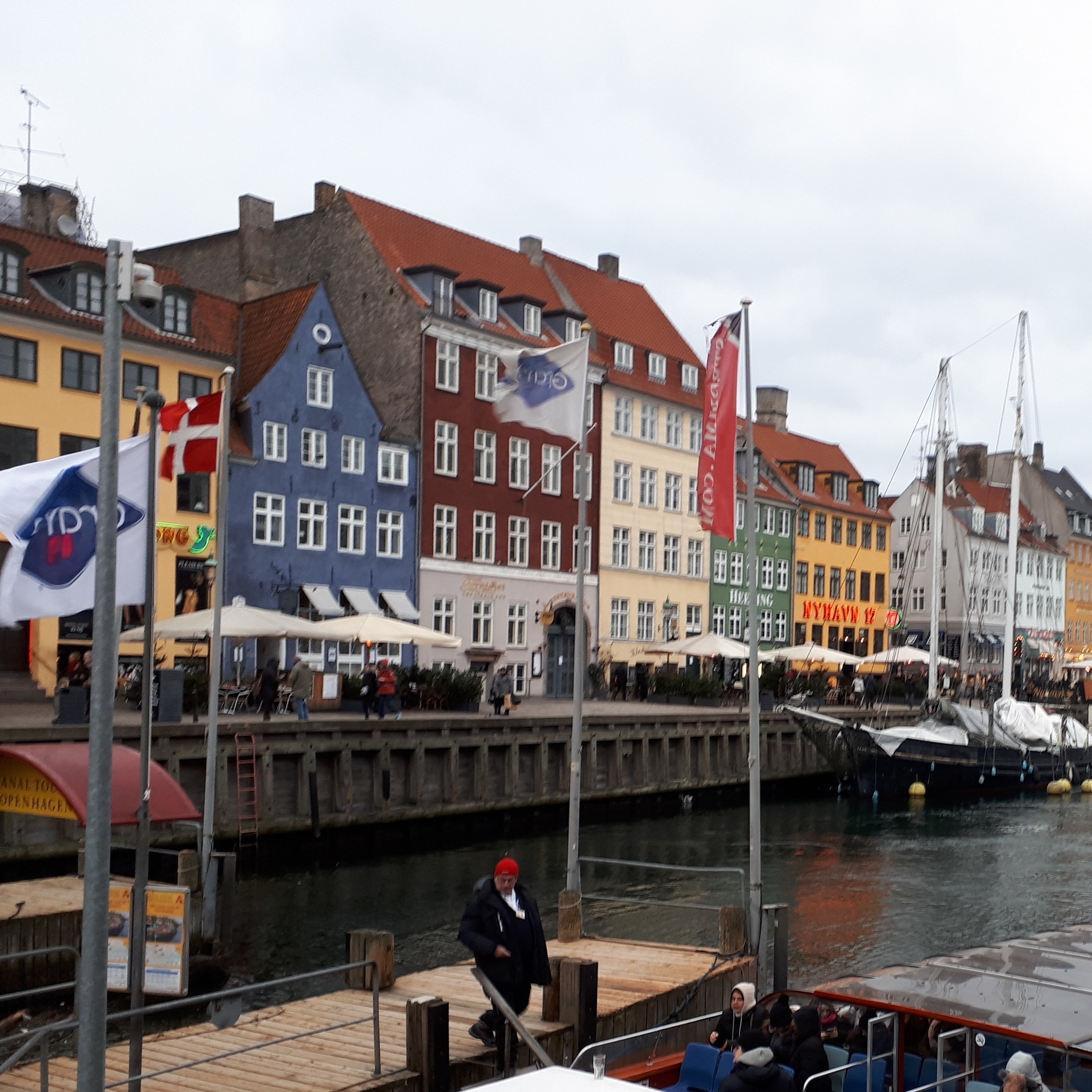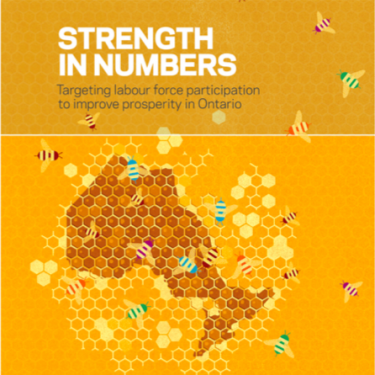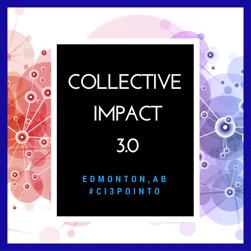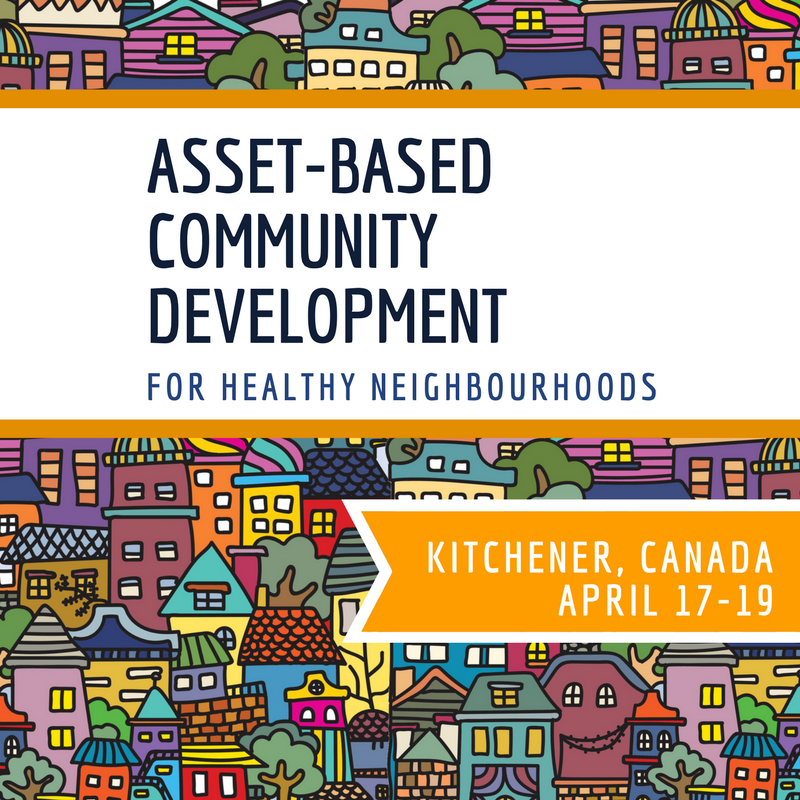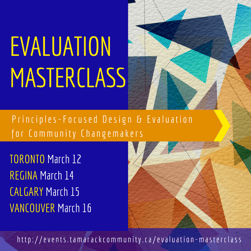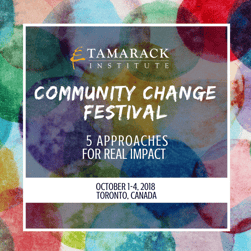Tamarack Institute | February Edition, 2018
In this Issue:
- Tamarack's Annual Report Celebrates 15 Years
- Building Collaborative Readiness: Mapping Community Resources
- OpportUNITY Central Iowa Reports Reduction in Poverty: A Collective Impact Success Story
- Trust: An Essential Ingredient in Authentic Community Engagement
- Eight Touchstones to Asset-Based Community Development
- Weaving Together Accountability and Learning in Complex Situations
- The Latest from the Field
- Upcoming Events You Won't Want to Miss
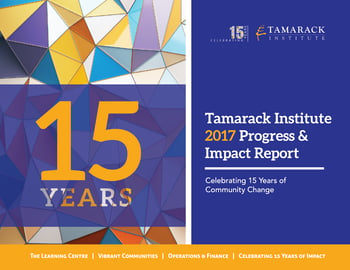 Tamarack's Annual Report Celebrates 15 Years
Tamarack's Annual Report Celebrates 15 Years
BY: TAMARACK INSTITUTE
An annual report is a time to say thank you to our 24,000 learning partners in 2,909 cities from across Canada, the United States and 52 countries from around the world. It is also, a time to celebrate and this year we have included a special 15-year reflection.
In the report we thank the partners that have contributed to our work financially. You will find over 800 organizations and individuals that invested this year as donors, members, consulting clients and learners.
We have had a transition in leadership this year. Liz Weaver is now leading our Learning Centre and Paul Born our Vibrant Communities work. We made this change to foster growth and impact as it allows us to focus on our two unique and yet interrelated program areas. We believe that this change will focus the creative energy of our team to engage you, our members, more effectively and directly. It feels good to share this leadership and is authentic for Tamarack as we promote collaborative approaches to community change.
As mentioned, we have been celebrating Tamarack's 15th Anniversary this year and as a way to mark the occasion, this report contains a special 15-year reflection. We hope this provides some context to our history and the achievements we have generated together. Throughout the report you will also find highlights of our year from the Learning Centre and Vibrant Communities. Be sure to read the side bars that highlight our work in numbers.
Much joy,
Alan, Liz and Paul
Learn More:
- Read Tamarack's 2017 Annual Report
- Find past Tamarack Annual Reports
- Meet the Tamarack Team for 2018
Share this article:
 Building Collaborative Readiness: Mapping Community Resources
Building Collaborative Readiness: Mapping Community Resources
BY: LIZ WEAVER
A common theme often echoed through the voluntary and community sector is the lack of resources available to do the work. Most communities have a range of investments, assets and resources, which, if deployed effectively, could prove to be a launching pad for many collaborative community efforts.
The idea of community asset mapping has been around for several years. John McKnight and Jody Kretzmann in their book, Building Communities from the Inside Out: A Path Toward Finding and Mobilizing a Community's Assets provided a detailed process for uncovering both explicit and hidden assets that might be found in most neighbourhoods and communities.
Kretzmann and McKnight sought to transform traditional thinking about low income neighbourhoods as places of problems and deficits, to places where assets, although not immediately apparent, were also abundant.
Mapping community assets can be an instrumental tool to building collaborative readiness. In most neighbourhoods and communities, there are a wealth of individual programs and services that are often working in isolation. Uncovering these assets can become the beginning of the foundation for building collaborative and shared efforts.
The Ontario Healthy Communities Coalition (OHCC) has developed a tool for communities to map community assets which builds on Kretzmann and McKnight's work. This simple tool includes five simple steps. The first step is to map individual capacity within a neighbourhood by surveying the skills, interests and connections that exist between people in the neighbourhood.
The second step in the process is to build an inventory of groups, organizations and institutions that are working in, and supporting, the community. This information can be gathered through online sources such as community information centre databases and community-based directories. This inventory should be cross-cutting to include the voluntary sector, faith community, businesses and other resources that might be found in the community or neighbourhood. When tackling a specific problem like poverty or homelessness, the inventory can be more focused on the services and programs related to problems identified.
The next steps include the creation of a community map and then using the community assets to address community challenges or needs. Finally, the OHCC discusses the role of health organizations in community asset mapping.
The community asset map, once developed, could serve as a baseline for determining positive and negative changes to the community over time. The National Centre on Secondary Education and Transition (see below) identifies that community asset maps can be used for taking specific actions to drive community change forward.
Community asset maps can be used in many ways.
- Documenting existing resources or lack of resources and understanding change over time;
- Using the community asset map as an advocacy and policy tool to advocate for changes to be made to the neighbourhoods;
- Using the community asset map for community outreach, to engage citizens in parts of the community where there are limited resources; and,
- Using the community asset map for community organizing, engaging citizens in developing and understanding their community.
Community asset mapping should not be a theoretical process but rather a process which includes the citizens in the community. They can be instrumental in identifying community resources which might not immediately be apparent, for example, the local restaurant where seniors gather each morning or the basketball court where youth hang out after school.
Community asset mapping is a critical tool for building collaborative readiness. There are many approaches and tools that can help facilitate the community mapping process. Before jumping into solving complex community challenges, investing in community mapping can build a cache of resources and networks that may help your collaborative effort move forward more quickly by leveraging assets that already exist.
Learn More:
- Access Using Asset Mapping for Asset-Based Community Development
- Check out the Tool: Mapping Your Community Assets from the Ontario Healthy Communities Coalition
- Read an overview of Community Mapping by the National Center on Secondary Education and Transition
- Read Pathways to Education’s Community Mapping Tool: Mapping At-Risk Communities in Canada
- Take a look at Participatory Asset Mapping – A Community Research Lab Tool Kit
- Learn about the Asset-Based Community Development: For Healthy Neighbourhoods three day workshop being hosted in Kitchener, ON by Tamarack's Vibrant Communities
Share this article:
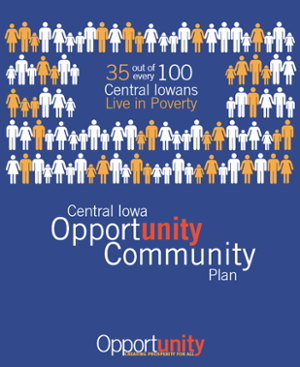 OpportUNITY Central Iowa Reports Reduction in Poverty: A Collective Impact Success Story
OpportUNITY Central Iowa Reports Reduction in Poverty: A Collective Impact Success Story
BY: CITIES REDUCING POVERTY
Just before the holidays, United Way of Central Iowa, as part of the OpportUNITY Plan, announced that in 2016, 11,000 more individuals were financially self-sufficient in three state counties: Polk, Warren, and Dallas. This is incredibly significant to the community, as it marks the first time in recent memory that Central Iowa has seen a reduction in poverty. The good news reflects well on the hard work of United Way of Central Iowa and their partners, the value of a Collective Impact approach to poverty reduction, and the importance of a robust measurement strategy.
United Way of Central Iowa is a member of the Vibrant Communities Cities Reducing Poverty network, and they have been working with Paul Born over the past three years. We were proud to produce a Case Study of the important work they are doing with emphasis on lessons from their Collective Impact approach and best practices in community engagement. Some highlights from the case study and the recent announcement around Central Iowa’s poverty reduction are described below.
In 2014, United Way of Central Iowa brought together leaders from the business and philanthropic community, governments and schools, non-profit and faith groups, and individuals with lived experience of poverty, to address the question of how to reduce poverty in their community. This meeting began the Collective Impact process to reduce poverty, in which community members developed measurable targets, including increasing the percentage of Central Iowans who are financially self-sufficient from 64.7% (2014) to 75% by 2020.
United Way of Central Iowa and its community members have worked to meet this target by setting key priorities in four areas:
- Education;
- Transportation, homelessness, and housing;
- Individual, place-based and system level change; and,
- Food security.
In addition to emphasizing the value of the Collective Impact approach, the news from Central Iowa highlights the value of setting measurable targets and reporting results. Collecting the data and sharing the analysis enables the United Way of Central Iowa to show a real increase of financially self-sufficient families, and provides roundtable members, stakeholders and their community a chance to celebrate successes along the way and reinforces that their work is moving them toward their overall goals. To learn more about the important work of United Way Central Iowa and the importance of the Collective Impact process in their poverty reduction strategy, you can read their Case Study here.
Learn More:
- Read the Case Study: United Way of Central Iowa’s OpportUNITY Plan
- Check out the Press Release: More families were financially self-sufficient in central Iowa in 2016
- Take a look at the Community Plan: Central Iowa Opportunity Community Plan
- Visit the The OpportUNITY Plan website
Share this article:
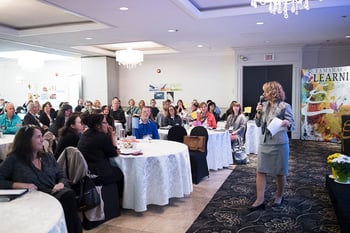 Trust: An Essential Ingredient in Authentic Community Engagement
Trust: An Essential Ingredient in Authentic Community Engagement
BY: SYLVIA CHEUY
I recently had the privilege to travel across Ontario to facilitate five workshops exploring an essential ingredient of community change: authentic community engagement. Participants at each session identified community engagement challenges that were “top of mind” for them. Common themes included: finding adequate resources for engagement; needing to address diverse audiences and/or span vast geographies; retaining engagement once it had been initiated; and, a need for more capacity-building in this area. A root community engagement challenge that surfaced was that residents and communities are often unwilling or, at best, reluctant to participate in organizationally-led engagement efforts.
There are likely several factors contributing to a community’s reluctance to engage. The growing number of Canadians of all ages who report feeling that they do not belong is one factor. If you don’t feel you belong, you don’t believe your perspective matters. Another factor is the sheer volume of information competing for our attention. Competing demands for our time also contributes to a lack of willingness to be engaged. Perhaps, our invitations to be engaged can be lost amidst “the noise” and/or may not be as compelling as residents’ other demands and opportunities.
Another core factor contributing to a community or individual’s reluctance to engage is that there is a lack of trust that our engagement efforts are authentic. For many, previous experiences of engagement have eroded trust that the requests are authentic. There is well-founded skepticism that our engagement efforts will lead to any measurable improvement in the things that matter most to communities and residents. Too often, their previous experiences of engagement have been driven by organizational and/or sector agendas that leave little room to adapt to, or reflect, the community’s agenda.
Trust is foundational to the work of community change. In her paper Turf, Trust, Co-Creation and Collective Impact, my colleague Liz Weaver shares wisdom from Rich Harwood and the Hardwood Institute’s “turning outward” approach to community change. It is an approach that reflects the understanding that trust is built when organizations reflect the reality of our communities in what they do and say. The path to authentic community engagement begins when organizations demonstrate a willingness to move beyond their own goals and ambitions to recognize and champion the individual and shared goals and ambitions of the community.
How do we ensure that our community engagement efforts invest time in listening and learning as well as speaking and acting? How do we recognize community engagement as an act of relationship-building that regularly supports the mutual flow of information and knowledge back and forth? Here are five recommendations for how to authentically engage and build trust with community:
- Be Clear About the Intent of Your Engagement – Trust is broken when we are not clear about the intent behind our engagement. Why are you engaging? Is it to inform people of a decision that’s already been made? To ask for ideas about how to solve a problem? To invite collaboration in solving a problem? Being clear about your purpose helps establish realistic expectations for your engagement.
- Recognize that Community Engagement Isn’t Solely About Getting Input – Beyond obtaining input to inform our organization’s decisions, community engagement can also be an important strategy to establish and strengthen relationships with those we serve. Engagement can also help to build capacity in residents and communities by sharing knowledge and empowering local groups, which ultimately fosters citizen leadership and the community’s resilience.
- “Closing the Loop” is Essential for Building Relationships and Trust – Community engagement is often an activity that happens off the side of our desks, rather than a core, ongoing strategy for how an organization operates. Frequently, once a community engagement effort provides the organization with what it needs, focus shifts to how to use the information for our own decisions. Not taking the time to circle back and let those that were engaged know what conclusions were drawn from their input or how that input is being used contributes to the community’s cynicism and lack of trust that their perspectives were heard and valued.
- Value the Wisdom of Both Content AND Context Experts – As professionals, we place significant value on the subject-matter knowledge of content experts. There is, however, another form of expertise that is equally essential when working in community: the knowledge of the “context expert” – the resident who has first-hand experience of the issue within our community. Because communities are unique and dynamic, the wisdom of the context expert is essential in designing effective, place-based solutions.
- Make Your Community Engagement Creative and Fun – When designing your community engagement strategy, be mindful of the ongoing competition for people’s time and attention. Communications that are engaging, fun and incorporate video and/or great graphics help to give your invitation and message an “edge.”
Authentic community engagement requires a clear long-term strategy and an ongoing commitment of resources. Proven approaches exist and the value is clear. The essential question is: are we willing and able to commit to making it foundational to how we do our work?
Learn More:
- Read The Context Experts by Lisa Attygalle
- Read Turf, Trust, Co-Creation and Collective Impact by Liz Weaver
- Find more resources on Community Engagement at tamarackcommunity.ca
Share this article:
 Eight Touchstones to Asset-Based Community Development
Eight Touchstones to Asset-Based Community Development
BY: HEATHER KEAM
“A gift is not a gift until it is received” - Cormac Russell
Asset-Based Community Development (ABCD) is about building community. Historically, we have looked at communities based on what they don’t have (asset stripping) instead of looking at the gifts that a community does have (glass half full). Many of us who are doing community development work are looking for a cookie cutter way to do the work effectively. However, everywhere ABCD is implemented it plays out differently as outcomes are contingent on the community it is applied in. It is complex and messy, and does not fit into a recipe.
In January, Tamarack invited Cormac Russell, who is a leader in ABCD and has worked in over 30 countries to support residents to be co-producers of their future, to be a guest speaker on a webinar entitled: Asset-Based Community Development: Lessons From Across the World. Cormac is the Managing Director of Nurture Development and a faculty member of the Asset-Based Community Development (ABCD) Institute at Northwestern University, Chicago.
During the webinar, Cormac discussed the eight touchstones (not stepping stones) to consider when community building. Cormac stated that the touchstones are about a framework - a way of working alongside community and trying to be in a complex and emergent space. Cormac further said that when doing ABCD work you cannot generalize, the emphasis should be less about standardizing, but more importantly about helping to understand how to implement good practice.
The Eight Touchstones to ABCD work that Cormac referred to are:
- Finding a community building team: Who are the unsung heroes in the community? Who are the individuals that are good at discovering what people care about and where their assets can be used? How can this group be engaged?
- Recruiting a Community Animator: Not someone who sets the agenda but someone who helps people get organized. A champion in the community who is a natural community builder and willing to try new things.
- Hosting Community Conversations: There is a lot of value in the simplicity of a conversation. Host a series of conversations in your community and think about shifting the focus of the conversation to discoverables not deliverables. The basis of the conversations should not be about what is wrong, but about what is strong!
- Engaging Community Groups and Organizations: The great capacity building that exists in communities can often be found in local clubs, associations and informal groups. These are places where people come together and support each other.
- Building Connections and Social interactions: Connector and Animator roles should focus on creating interactions - not just planning events and hoping the community will come - but creating spaces that are welcoming and create shareable moments.
- Visioning and Planning: Once a strong connection is built with the community, it's time to look to the future and envision what it could look like in ten years. Start by asking these three questions: What can we do? What do we need outside help with? And, what do we need outside agencies to do for us?
- Implementing change: Take action and begin to do what you believe needs to happen. This allows people to reconnect and take back the function of the community.
- Fostering CELEBRATION: Throughout the process, celebrate every effort. Believe in everyone’s gifts!
Paul Born, Co-CEO of Vibrant Communities at Tamarack, summed up the webinar by saying that doing ABCD work is like growing a garden, you need to prepare the soil before you can plant.
Cormac Russell is one of the faculty members for Tamarack’s upcoming Asset-Based Community Development for Healthy Neighbourhoods event taking place in Kitchener, ON this April. Don’t miss this opportunity to learn from such an inspiring leader in neighbourhood development.
Learn More:
- Listen to the full webinar Asset-Based Community Development - Lessons From Across the World
- Join us in Kitchener, ON from April 17-19, 2018 for Asset-Based Community Development: For Healthy Neighbourhoods
- Take a refresher on the Principles of Asset-Based Community Development with John McKnight and Paul Born
- Watch Sustainable community development: from what's wrong to what's strong (TEDx Exeter Talk), presented by Cormac Russell
Share this article:
 Weaving Together Accountability and Learning in Complex Situations
Weaving Together Accountability and Learning in Complex Situations
BY: MARK CABAJ
Michael Quinn Patton, evaluation expert, has argued that even the best intentioned, well-resourced evaluation processes can become, “the enemy of social innovation” if change-makers, evaluators and funders employ a traditional – rather than developmental – approach to assessment.
In October 2017, the dynamic team at the Community University Partnership (University of Alberta) made this topic the central theme of their annual general meeting, a reflection of their commitment to providing useful research and evaluation in a variety of important social issues across the region. I had the pleasure of presenting to a group of about 120 people during this gathering and have since written a follow up blog emphasizing the three major points of my presentation along with an additional point that I couldn’t help but add in, having not had time in October.
The Community University Partnership annual meeting was yet another reminder that we need to figure out ways to ensure that evaluation contributes – rather than short-circuits – our efforts to tackle complex situations in our communities. To do this, we need to build on – yet change – a field of evaluation often still stuck in more traditional ideas and practices. The Community University Partnership is one of the organizations trying to do just that.
Learn More:
- Read the full blog - Weaving Together Accountability and Learning in Complex Situations: A Wicked Challenge
- Learn more about the Community University Partnership
- Join Mark Cabaj at one of our upcoming events:
- Collective Impact 3.0 - February 28 - March 2, 2018
- Evaluation Masterclass Series - where he'll be joined by Michael Quinn Patton, kicking off March 12th!
Share this article:
A LIGHT IN THE WINDOW
By: Liz Weaver
Read the Post
WHY DON’T WE BENEFIT FROM SOCIETAL INNOVATIONS AS READILY AS TECHNOLOGICAL INNOVATIONS?
By: Denis Pageau
Read the Post
KNOWING WHERE YOU’VE BEEN TO KNOW WHERE YOU’RE HEADED
By: Heather Keam
Read the Post
DEFYING ‘GENERATIONAL’ GRAVITY
By: David Alston
Read the Post
ECONOMICS OF DOING BUSINESS AND THE NEW MINIMUM WAGE
By: Michael Adamcryck
Read the Post
STRENGTH IN NUMBERS: TARGETING LABOUR FORCE PARTICIPATION TO IMPROVE PROSPERITY IN ONTARIO
By: Alison Homer
Read the Post
Collective Impact 3.0
February 28 - March 2, 2018
Edmonton, AB
Collective Impact 3.0 is a three-day intensive workshop for practitioners in early stage, mid stage and later stage community change work. The workshop will explore the latest in the practice of Collective Impact from experts, practitioners and early adopters of the work.
This workshop is best suited to those who have an interest and some basic knowledge and experience with Collective Impact and are eager to tackle the challenging but critical task of moving the needle on complex community challenges like poverty, homelessness, environmental change, early learning and active living.
Asset-Based Community Development: For Healthy Neighbourhoods
April 17-19, 2018
Kitchener, ON
Asset-Based Community Development: For Healthy Neighbourhoods is a three-day opportunity to learn the fundamentals of Asset-Based Community Development with a focus on Neighbourhood Development and Community Health. Join us in Kitchener, Ontario for a rare opportunity to learn from Cormac Russell and John McKnight, two of the world's top trainers in Asset-Based Community Development (ABCD), for their first time together in Canada.
Evaluation Masterclass: Principles-Focused Design & Evaluation for Community Changemakers
Toronto, ON |March 12
Regina, SK | March 14
Calgary, AB | March 15
Vancouver, BC | March 16
Join evaluation pioneer Michael Quinn Patton and experienced evaluator Mark Cabaj in a one day masterclass that explores the principles-focused evaluation approach and demonstrates its relevance and application in a range of settings.
Community Change Festival
Save the Date!
October 1-4, 2018 | Toronto, ON
Over 4 days, explore the 5 competencies every changemaker needs to move ideas to practice to impact. Through workshops, open space dialogue, tools, immersive tours, and peer input processes, go deep into one approach or advance your skills in each.
Strengthen Your Poverty Reduction Work: Engaging with the Health Sector
Speakers: Dr. Gary Bloch and Trish Garner
Date: February 13, 2018 | 1:00 - 2:00 p.m. EST
Building Readiness through the Collective Impact Feasibility Framework
Guest: Robert Albright, Director of Programs, Collective Impact Forum, FSG
Host: Liz Weaver, Co-CEO, Tamarack Learning Centre, Tamarack Institute
Date: February 20, 2018 | 1:00 - 2:00 p.m. EST
Taking Asset-Based Community Development (ABCD) to Every Neighbourhood
Speakers: Howard Lawrence and Karen Wilk
Date: February 21, 2018 | 2:00 - 3:00 p.m. EST
Ontario Trillium Foundation: Transformative Action Webinar Series
Join us for a series of webinars designed to share tools that will help groups build capacity to implement complex transformational initiatives. View Full Series here.
To register for individual webinars:
